[gdlr_image_link type=”image” image_url=”” link_url=”” alt=”” target=”_blank”]
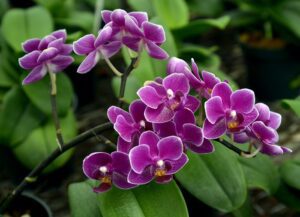 Chattanooga. When Joan’s daughter, Laura Lines, was only two, the entire family attended the Nashville Antique and Garden Show. A patron stepped over to the Lines Orchid booth to ask about a certain bright white orchid that
Chattanooga. When Joan’s daughter, Laura Lines, was only two, the entire family attended the Nashville Antique and Garden Show. A patron stepped over to the Lines Orchid booth to ask about a certain bright white orchid that
had caught his attention. “What kind of orchid is this?” he asked. The toddler spoke up and strung together the Latin syllables ‘phal-e-an-op-sis’ without a pause. This took everyone by surprise, including Joan, the child’s busy mother. Like her daughter, Joan Lines McCandless also grew up pinching spent leaves from potted orchids in the family greenhouse, as she learned to name the world around her. In many ways the family was bilingual, fluent in both English and Latin.
Joan knew by age five how to reach her tiny hand into the brown coconut husk soil to see if the plants were ‘thirsty’ as a child might say. She developed skills of intuition, an appreciation of delicate beauty, all right alongside the rigor of science. Joan’s father and her grandfather had done the same, and Joan raised her children to understand this way of being in the world.

American Orchid Society, Inc. memorabilia
To tell the history of Tennessee’s finest orchid grower, Lines Orchids, is to reveal the history of the American Orchid Society founded in 1921. Joan’s grandfather, Oliver Lines, was a founding trustee and served as an advocate longer than any other member, more than 44 years. Oliver Lines passed in 1965. Oliver’s son, John Lines, had his father’s same passion for growing orchids and experimenting with hybrids.
Joan’s grandfather, Oliver Lines, was trained at England’s finest estates and by the most revered authorities in orchid culture, before landing in America at Ellis Island in 1910. His journey reads like a ‘Who’s Who’ of high society and entrepreneurial energies. Beginning with Great Britain’s Secretary of State Joseph Chamberlain, who was known to never be in the public eye without a cut orchid slipped into his lapel, the young Oliver Lines impressed investors, customers, and other growers. He navigated a series of mergers and economic challenges on both sides of ‘the pond’ while continuing his commitment to learn, adapt, and build a reputation for excellence. Perseverance has kept the cultivars of century-old delicate roots alive.
Joan’s grandfather first stepped into a greenhouse in Birmingham, England at age 14, hired merely to shine the glass. Quickly his work ethic and interest promoted him to water boy and then he was chosen to be an apprentice grower. When that work evaporated, he followed his team to a heavily industrialized London where the smog and harsh weather did not help him or his plants thrive. Choosing by intention a rural pastoral life, he landed a job working for the most revered orchid grower in England, H G. Alexander. He began to understand not only what made his plants thrive, but what made him reach for light as well. America’s promise was just ahead for the now 25-year old.

Lines Orchids’ silver awards
Together, John and Oliver Lines accumulated many orchid culture awards ranging from engraved silver serving trays to candelabras and trophy bowls. They stacked these shiny affirmations up on the greenhouse shelves and went about their work. But customers noticed, and the Lines family’s Signal Mountain business grew into a landmark. Many visited Lines Orchids as a kind of scientific pilgrimage, to meet Oliver, known as ‘The Dean’ of orchid culture among growers. He was given that title about the time he won three gold medals for his orchids at the 1939 New York World’s Fair, pleasing his leading investor, Mrs. Eleanor Dixon. Nearly 44 million people from across the world attended that event, focused on building ‘the future.’ Oliver Lines was in the thick of building his family’s future on something delicately rooted in the past. Orchids were proving to be highly portable and profitable in their scarcity.
In 1945, the industry’s highest honor, the American Orchid Society’s gold medal for lifetime achievement, was presented to Oliver Lines. A year later, following the shifting economies brought about by WWII, an aging Mrs. Dixson needed to sell her greenhouse assets. While many items of her estate were sold into a diaspora, she formally gifted Oliver Lines with the best specimens from the original collection and also a couple of greenhouse frames, which the family still employs. She knew these assets were in the country’s best hands.

A landmark on Signal Mountain
John Lines had shadowed his father in the greenhouse work his entire life, taking a natural and curious interest in all aspects of the business. He convinced his father to avoid retirement, and to persevere. The family purchased property in 1947 in Signal Mountain, Tennessee. John and his wife Gladys stayed busy raising four children, traveling the world to study orchids, and participating in orchid shows. Joan has carried on the family business since 1991. Her son, Scott McCandless, now oversees Lines Orchid’s greenhouse operations on the mountain, and is the fourth generation to do so.
 Next year marks 70 years since Oliver Lines carried his orchids, some dating to the mid-1800s and a few originally raised in prestigious English conservatories, to a community in the South Cumberland Mountains of Tennessee.
Next year marks 70 years since Oliver Lines carried his orchids, some dating to the mid-1800s and a few originally raised in prestigious English conservatories, to a community in the South Cumberland Mountains of Tennessee.
Today, Lines Orchids operates 40,000 square-feet of vintage glass greenhouse space with wholesale and retail customers extending out across the country. Lines makes regular trips with plants to Nashville, Atlanta, and Birmingham.

Visit Lines Orchids shop at the unique urban retail center, Warehouse Row, in downtown Chattanooga
In 2011, Lines Orchids opened a gift shop in Warehouse Row in downtown Chattanooga. Joan officially handed the greenhouse reins to son Scott and fulfilled her dream of having an in-town floral gift shop that tapped her expertise in design and presentation. The shop offers plants, books, pots, free orchid expertise, and Joan’s intentional support of Tennessee artists such as ceramic potter Jessie Bean Bailey. Each item on the shelf at Lines is carefully chosen. Each gift bag has been hand-stamped with the family name. On the wall is a grouping of awards her family has earned for offering the most exquisite orchids; and each item in Joan’s shop defines the word ‘exquisite.’ Vintage copies of Orchid Society Membership booklets are stacked to elevate a decorative arrangement and prompt a conversation.
From the 1950s through the 1960s, Lines Orchids was the best source for the cut blooms of ruffled cattleya orchids. The flowers were a boom to the business and were pinned to every woman of means who attended church, garden club, gala, or the prom. The demand for these reached the White House, and in 1962 John and Gladys Lines named an orchid for First Lady C. Bess Truman, much to her delight. The couple received an invitation to tour the Truman Library in Independence, Missouri, as a show of gratitude. In those days, Lines Orchids would hire more than 20 extra temporary workers to help them manage the volume between Easter and Mother’s Day.

Ruffled cattleya orchid remains a sentimental favorite for weddings and for those who carry on the corsage traditions.
While the cattleya still winds up on a girl’s slender wrist at the prom, the word ‘corsage’ sounds vintage to us today, and certainly the popularity has waned.
But the beauty of a potted cattleya is still in demand and are grown at Lines Orchids. Brides continue to find these orchids a sentimental favorite for vintage wedding bouquets.
More than 20 varieties of orchids are grown at Lines, and Joan notes that the Royal Horticultural Society that registers varieties world-wide has 40,000 orchid types on record, more than any other plant species. The bright white drama of the Phalaenopsis orchid is Lines’ best-seller and signature offering. If you step into the greenhouse at Lines Orchids, it is not the heat and humidity that take your breath away, it is the uncommon beauty of seeing a sea of blooms that are each as luminous as the moon.
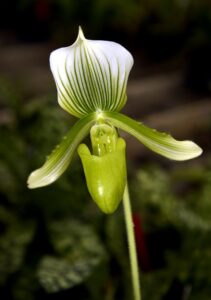 The most challenging aspect of living with orchids may be the discipline to let them be. Most of these delicate plants do not perish due to neglect, but by
The most challenging aspect of living with orchids may be the discipline to let them be. Most of these delicate plants do not perish due to neglect, but by
over-watering and allowing the plant roots to rot in a pool of water. “I don’t recommend the so-called ice cube method,” says Joan, nearly rolling her eyes at the thought of trying to shortcut the care of a plant. “There are too many ways that could go wrong for the plant.” The ice cube method touts a slow release of water, but the variables are too many and only complicates the task, said Joan. She likes to keep things simple. Water only when the plant needs water. Frequently touch the soil to see if it is dry. In other words, pay attention to the plant, but not too much.
Patience and attention are two vital character traits required to grow orchids. Some species may have a dormant period of a year between blooming cycles. And some orchids bloom for as long as two to three months with their most active blooming season generally falling between February and late spring, conveniently around Mother’s Day. For most of us, if we are honest, patience is depleted from our soil. Perhaps growing an orchid can be a rite of passage we offer our busy selves, a gift that represents our intrinsic need to nurture living things and pay attention. Cultivating an orchid in our spaces reminds us that the anticipated bloom is nurtured in the small daily actions—monitoring the soil and ensuring light.
“To have a healthy bloom, you have to start with a healthy plant that has been given room to grow,” said Joan. When we listen to Joan, we can’t help but hear in her adamant voice something akin to a parable. Perhaps a Phalaenopsis, a cattleya, or a flower the locals call a ‘lady slipper’ are metaphors worthy of further lessons, further meditation.
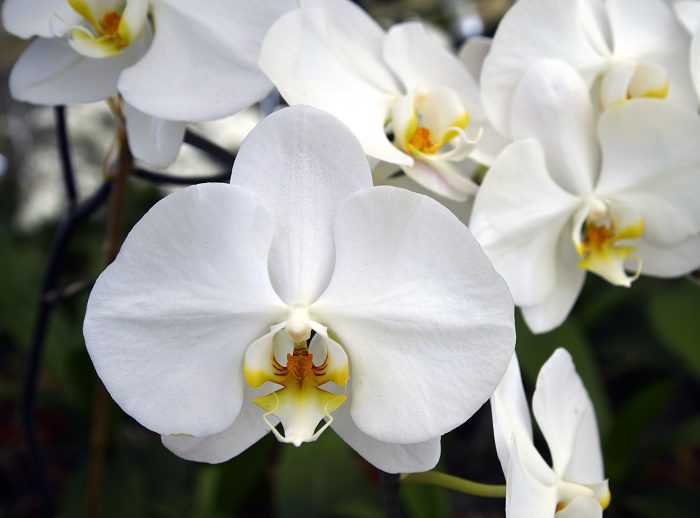 WHAT AN ORCHID ASKS OF US
WHAT AN ORCHID ASKS OF US
ROOTS. A healthy root structure has been given space to grow and is not ‘girdling’ around the interior of the pot. Begin with a healthy plant from Lines Orchids.
LIGHT. Southern or eastern exposure to natural light is best.
AIR. Orchids are ‘epiphytic’ plants, meaning they grow on trees with their roots exposed to air and moisture. A potting medium of coarsely ground coconut husks allows for air flow.
WATER. Monitor the soil regularly and only when it is dry, water generously so that the salts that naturally form are flushed. Allow for thorough draining.
NUTRIENTS. Over the years orchids benefit from any balanced indoor potting fertilizer. The key is balance among the nutrients with a 20x20x20 ratio.
PATIENCE. Orchids may have an extended dormant season, some as long as a year, between blooms, though blooms are generous and long-lasting when they arrive.
SOUTHERN SOURCES
Lines Orchids, Inc. Greenhouses: 1823 Taft Highway, Signal Mountain, TN,
423.886.2111
Lines Orchids at Warehouse Row is on Facebook: 1110 Market St., South
Bldg., Chattanooga, TN
Flower Mart: 4502 Harding Pike, Nashville, TN, 615.490.3966.
The Tulip Tree: 95 White Bridge Rd., Nashville, TN, 615.352.1493
Photography by Billy Weeks
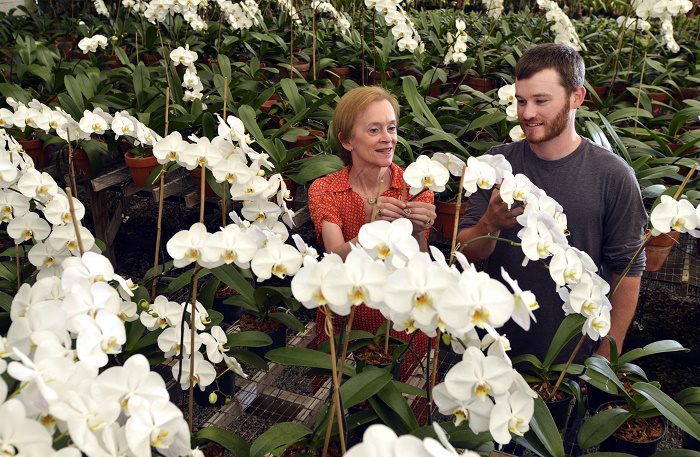
Joan Lines McCandless and her son, Scott McCandless, at the Signal Mountain greenhouses. Scott is the fourth generation of the Lines family to oversee greenhouse operations. greenhouse operations.
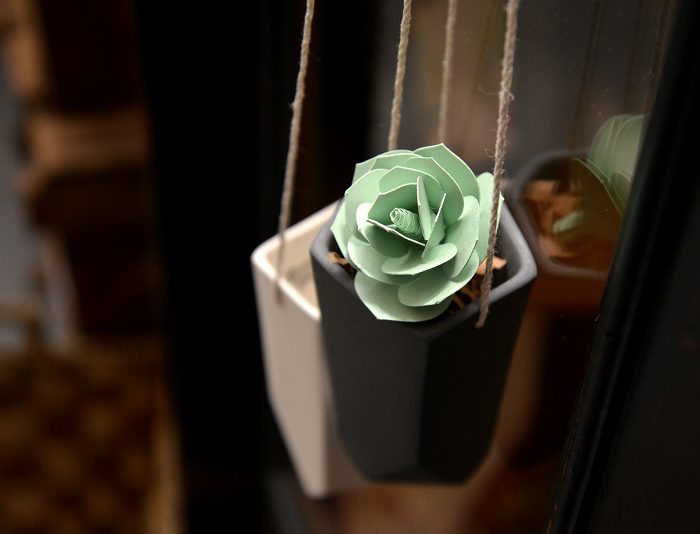
Handmade slip-cast porcelain flower pots by Jessie Bean with Bean and Bailey ceramics studio of Chattanooga.

Lines Orchids at Warehouse Row displays a small sample of the historic silver platters inscribed with their family name. The Lines family has received numerous accolades from the American Orchid Society.
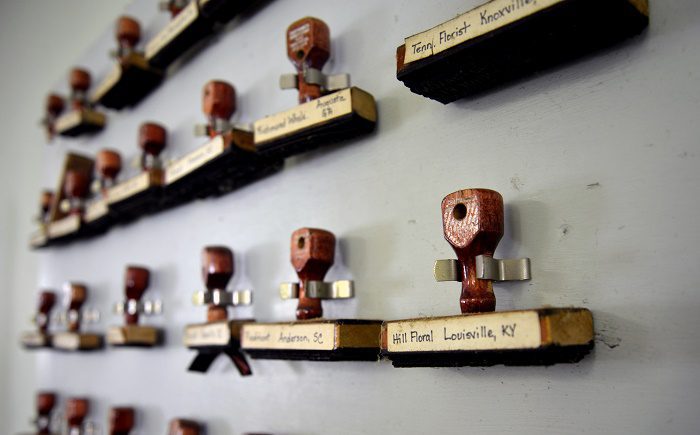
Vintage hand stamps represent the long-term customer relationship Lines Orchids has with retail businesses in Nashville, Atlanta, Birmingham, and across the region. In Nashville, you can find Lines Orchid varieties at Flower Mart and The Tulip Tree.
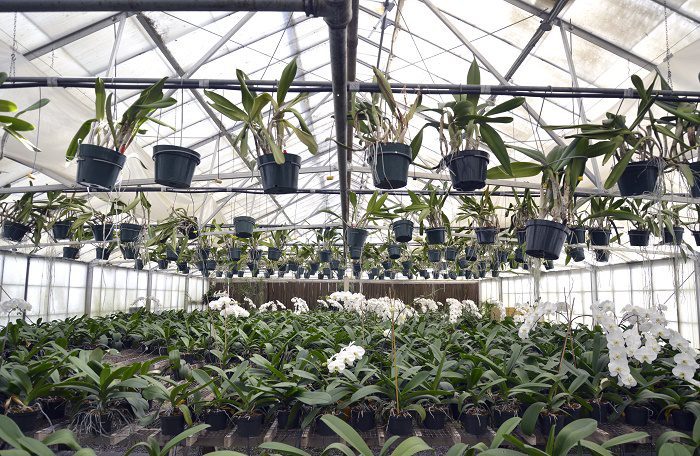
Lines Orchid greenhouse operations on Signal Mountain near Chattanooga

Lines Orchids at Warehouse Row is a delight to the senses, a great place to shop for special gifts and decorative home items.
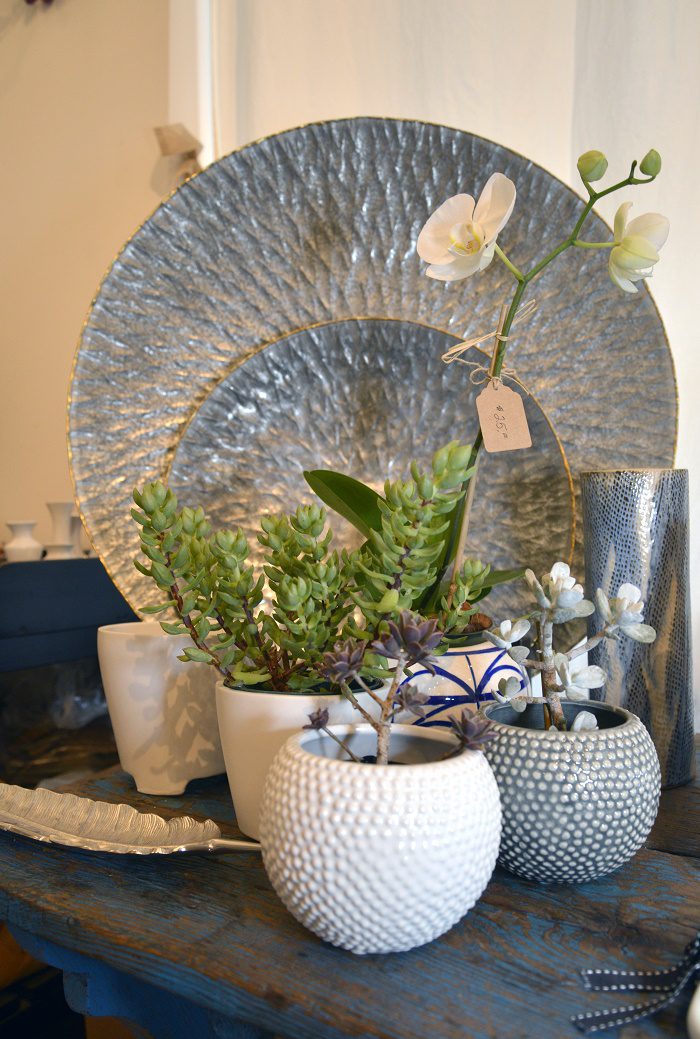
Lines Orchid’s shop at Warehouse Row in downtown Chattanooga. Include a visit to Lines on your next shopping trip to downtown Chattanooga.
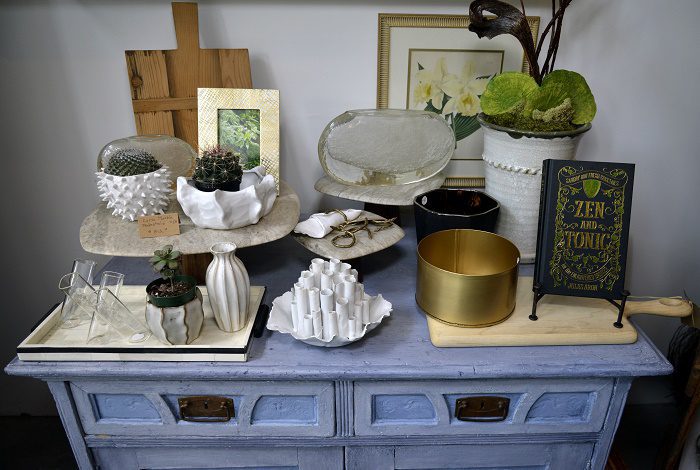
Lines Orchids floral and gift shop at Warehouse Row in downtown Chattanooga offers unique, carefully selected items for cut and potted flowers. In addition you can find books and other decorative objects.

Lines Orchids at Warehouse Row in downtown Chattanooga

Enjoy holiday shopping at Warehouse Row in downtown Chattanooga. Open house at Lines Orchids and other shops is Dec. 1, 2016.

Lines Orchids at Warehouse Row in downtown Chattanooga






Leave A Comment
You must be logged in to post a comment.